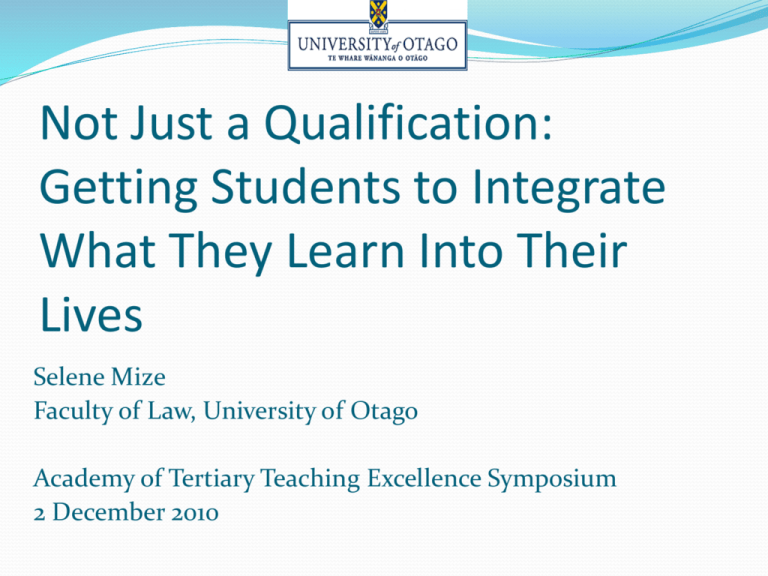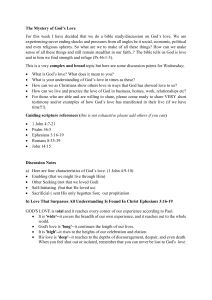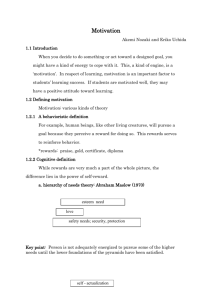Getting Students to Integrate what they learn into
advertisement

Not Just a Qualification: Getting Students to Integrate What They Learn Into Their Lives Selene Mize Faculty of Law, University of Otago Academy of Tertiary Teaching Excellence Symposium 2 December 2010 Session Overview Motivating students Clickers Influencing students’ values In the Beginning . . . The Following Year . . . What Changed? Legal Ethics became compulsory for admission to the legal profession Students may have said to themselves: “I am taking this class because it is required, not because I want to” Intrinsic motivation: when you want to do something Extrinsic motivation: when someone else tries to make you do something “Work consists of whatever a body is obliged to do, and that play consists of whatever a body is not obliged to do.” Mark Twain, The Adventures of Tom Sawyer (1876, Chapter 2). Extrinsic motivators (rewards and punishment) can change behaviour, but only so long as the rewards/punishment remain present and significant enough to matter. Worse, extrinsic motivation sometimes undermines intrinsic motivation, the students’ perception of their own ability, and the perceived value of the target task. Paying University students to do a puzzle Paying people to give up smoking Wine coupons But What About . . .? Intrinsic Motivation Doesn’t Need to Be “Created” Traits of human nature include curiosity, being active, initiating thought and behaviour, making meaning from experience, being effective at what is valued Our part is not to create intrinsic motivation, but to: Avoid stifling these natural tendencies Provide a supportive teaching environment What Can Support Intrinsic Motivation? Supplying credible information about the value of the task or information to be learned. Extrinsic motivators have a particularly negative effect where the student is ignorant about the value of the learning. Offering students freedom and choice (something that they must choose to do cannot easily be downgraded later by characterising it as something that they did not really want to do) Non-hierarchical structure (where teachers work side- by-side with the student, as opposed to teachers as superior authorities). Delegating control of the task to the student (eg Adrian’s farmer’s market day) (this demonstrates trust and confidence in the student) Low-powered incentive schemes that signal that the student is capable and talented (“Encouraging you to try would make no sense if you were unable to learn by doing”); that the information to be learned is genuinely useful; and that there is a long-term payoff. Challenging students to meet goals that are meaningful to them, to accomplish new tasks Provoking students’ curiosity Providing opportunities for cooperation and competition Using fantasy to stimulate students (eg making a game out of learning, helping learners to imagine themselves using the learned information in real-life settings) Giving meaningful, positive recognition to students for their work. What Often Doesn’t Work: Emphasising the rewards of education or the pleasure of learning --It can trigger suspicion in the student “Over-complimenting” or praising in general terms the student’s ability (although releasing reliable data on the student’s performance is fine) --It can trigger suspicion, and also high self-confidence can interfere with effort (“I don’t need to study”) Providing too much help --It undermines the student’s confidence that he or she can do the task Praising every student equally --It is not credible Use in Marking? Civil Liberties: 100% enjoyed them and wanted more Why mess with success? Types of Clicker Questions There are many different kinds of questions, including: Pretest Review Application / Test Understanding Survey Sensitive Postponed Review Reinforcing Pretest Questions Are useful for discovering from where your students are starting, and determining how much time should be spent on background material Review Questions Give you a chance to see if you got your point across Give students immediate feedback on their learning Gives students feedback on their learning in comparison with their peers. Eg a student who gets a question wrong and sees that the vast majority of the class got the question right may be more motivated to improve than if the student just sees that he or she got the question wrong. Application / Test Understanding Questions Go further than the material presented in class, eg by applying a difficult concept to a new situation or re-stating it in some way, to see if students have truly grasped the material. Survey Questions (Opinions where there is no single “correct” answer) Results are interesting Can trigger debate Once students see they are not alone in their viewpoint, they are more willing to speak out in class Allow exploration of sensitive topics that could not easily be broached in class discussion. Can alert the lecturer to the need for presenting more info (eg if students assert that there is no discrimination in NZ). Postponed Review Questions Are more powerful aids to memory. Many students will be able to regurgitate material immediately after covering it. Fewer will be able to do so accurately after a break. Reinforcing Questions Emphasise the importance of certain points All Clicker Questions Require students to be more active in class, which aids engagement and retention Provide an enjoyable break/change of pace Can be posted online for later review by students How Not to Influence Students’ Values Preachiness Hypocrisy Condescension / superior attitude Is “Instilling” Values Appropriate? Pro The public interest is served by high standards Lecturers are in an influential position to promote values Failing to advocate gives students the false impression that morality is relative Con Values are subjective, and people disagree What makes me the better judge of values? Pushing values is likely to generate resistance Developing self-reflection has more lasting effect What Is Uncontroversial? Presenting factual information including consensus viewpoints Modelling appropriate professional or educational values Controlling the learning environment (eg demanding respectful discussion) Exposing students to a learning environment designed to stimulate self-reflection To Encourage Self-Reflection Expose students to multiple viewpoints and different methodologies (eg philosophy, religion, structural approaches) Use examples that bring injustice and suffering from immoral behaviour into focus Include a real world focus so course can’t be discounted as ‘ivory tower’. Refer to students’ likely post-graduation experiences Make value challenges feel relevant and personal to the student Use second-person (“you are in your office, and a client comes in and says ...”) Require activity, not passivity (eg clickers, survey answers, assign roles in debate) Encourage class participation No personal disclosures Anonymous text messages Clickers, surveys, etc Consider use of literature and narrative (Ivanhoe) It enables students to experience and appreciate certain feelings playing an important role in ethical judgment It allows the student to engage and exercise “distinctively moral imagination” It can permit time appreciation – how different ethical judgments fit into the span of a human life Guest speakers can also serve as role models In some situations, develop morality through doing (Radcliffe) Encourage reflection, introspection, deep thought Praise it Ask hard questions Take a long-term perspective Introspection takes time and experience Virtue requires “walking the talk”, which may not be open to students Be open and non-judgmental Other ideas? Honour Codes Stanford’s Honor Code: The Honor Code is an undertaking of the students, individually and collectively: that they will not give or receive aid in examinations; that they will not give or receive unpermitted aid in class work, in the preparation of reports, or in any other work that is to be used by the instructor as the basis of grading; that they will do their share and take an active part in seeing to it that others as well as themselves uphold the spirit and letter of the Honor Code. The faculty on its part manifests its confidence in the honor of its students by refraining from proctoring examinations and from taking unusual and unreasonable precautions to prevent the forms of dishonesty mentioned above. The faculty will also avoid, as far as practicable, academic procedures that create temptations to violate the Honor Code. While the faculty alone has the right and obligation to set academic requirements, the students and faculty will work together to establish optimal conditions for honorable academic work. The Ultimate Goal . . .





